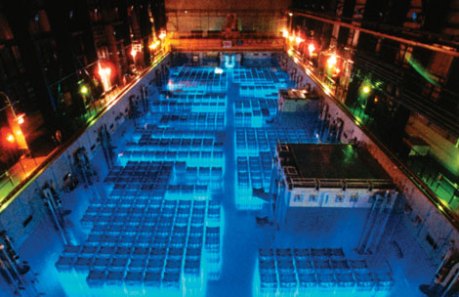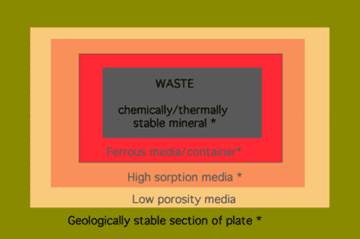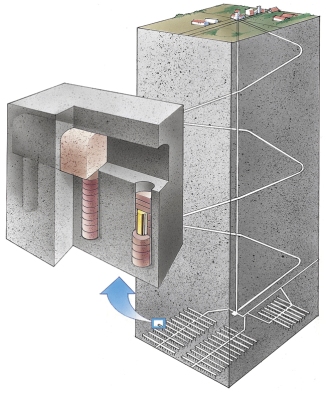If you’re reading this, and you oppose nuclear energy, there’s a good chance that you do so as you’re concerned about nuclear waste. In fact, if you’re reading this and support nuclear energy, there’s a good chance you’re still somewhat concerned about nuclear waste. This concern is very reasonable – there’s a lot of fear in the public mind about nuclear waste, and not a lot of easy to access information about what it is, and what can be done with it. In fact, I myself was once opposed to nuclear energy, and when I did, a main reason was nuclear waste.
What is nuclear waste?
In the production of power from nuclear reactor, there are several different kinds of waste produced – Low Level Wastes (LLW), Intermediate Level Wastes (ILW) and High Level Wastes (HLW). The LLW and ILW include everything from lightly contaminated equipment and fluids used within a power station, up to the dismantled reactor cores and other components. However, what people usually think of when they hear the term nuclear waste is the spent fuel – the uranium rods that have been ‘burned’ in a nuclear reactor, and the plant operator no longer wants to use.
In some cases, the spent fuel is broken down, and the most potent parts are extracted and concentrated before being encased in glass – this is called vitrification. The spent fuel and the vitrified wastes make up the High Level Wastes (HLW), and from this point on, they will be what I am referring to when I say ‘nuclear waste’.
How long does it need to be stored for?
Some people object to the creation of nuclear waste due to the long periods of time that it will need to be isolated and stored for. An important question is therefore, how long will it need to be stored for, exactly? To answer this question, the following graph is important:
The graph shows radioactivity against time (on a logarithmic scale). Note that there are 4 lines – the lighter solid line represents the activity of the original uranium ore, say if it had never been dug up and fed into a reactor. If we do dig up that uranium ore and make it into fuel which we then use in a reactor, the reactivity shoots up to the beginning of the darker solid line. The two dotted lines represent the activities of the two components of nuclear waste. Fission products are the new elements that are created by the splitting of atoms. Actinides are what are created when heavy elements – such as uranium – absorb a neutron, but do not split apart.
A very important feature to note on the graph is the point where the two solid lines meet – at around 104 (10,000) years. This length of time is how long we have an ethical responsibility to isolate the waste, and prevent it from harming people or the environment.
How do we know we can store it for that long?
Now it is at this point that you are probably thinking – 10,000 years is an awfully long time. How do we know nuclear waste can be stored for that long? – After all, there hadn’t been any nuclear power stations 10,000 years ago, right? Actually, you might be very surprised to learn, that there in fact, had been nuclear reactors in existence by 10,000 years ago, and a lot longer before that. No, I’m not some lunatic who is going to claim that aliens visited the earth and set up nuclear power stations – what I am referring to is natural nuclear reactors.
There is well documented geological evidence of what has come to be known as the Oklo nuclear reactor. Located in the West African state of Gabon, there exists a deposit of uranium ore which was once so highly concentrated that spontaneous fission reactions started to occur inside it. Over periods of what may have been thousands of years, the uranium deposit began to act just like a modern day reactor – maintaining a self-sustaining fission reaction, which released energy and what were essentially nuclear wastes.
The Oklo reactor is estimated to have been active over a billion years ago. What is remarkable is that the nuclear waste products from this nuclear reaction moved only a few centimetres from where they were first created – this is even with water flowing in and around the ‘core’ of the reactor. The main reason for the successful containment of this waste was the existence of multiple barriers around the reactor, slowing the permeation of the radioactive elements away from the core.
Designers of repositories for nuclear waste from modern day reactors use the important lessons learned from Oklo and other natural analogues when constructing them. The Onkalo repository in Finland for example, makes full use of natural analogues and the multi-barrier approach. For instance, the waste is first surrounded by metal which is resistant to corrosion. These will then be placed into bentonite clay boreholes, which prevent a barrier to permeation. Finally, any escaping material would have to find its way through a quarter of a mile of rock before reaching the biosphere.
With knowledge of geological formations such as Oklo and many other natural analogues, combined with advanced, corrosion resistant materials developed in recent decades, there is really no reason why safe nuclear waste repositories cannot be built in all countries that have nuclear waste.
So, Finland, France, and Sweden are all at least in the planning stages of a building a repository for nuclear waste. Why aren’t other countries, like the UK doing the same?
Whether you are pro or anti-nuclear it should not matter – we will still have nuclear waste even if every power station in the world is shut-down tomorrow, and so you should be fully behind efforts to build nuclear waste repositories for safe disposal of nuclear waste. But, considering that you now know that nuclear waste can be safely disposed of, why not support us in calling for widespread use of this low-carbon energy source?











1 comment
Comments feed for this article
February 19, 2012 at 3:05 pm
Atomik Rabbit (@Atomikrabbit)
Good tutorial, but I think it is important to re-emphasize that if we reprocess to extract and re-fission in fast spectrum reactors the 97% of the HLW that is fissionable U, Pu, and transuranics, the remaining 3% that is fission products will become relatively harmless in a just a hundred years and completely harmless in five-hundred.
Monbiot’s excellent exposition: “A Waste of Waste” http://www.monbiot.com/2011/12/05/a-waste-of-waste
And there may be uses for the fission products as well: “Is Nuclear Waste Really Waste?” http://www.youtube.com/watch?v=rv-mFSoZOkE